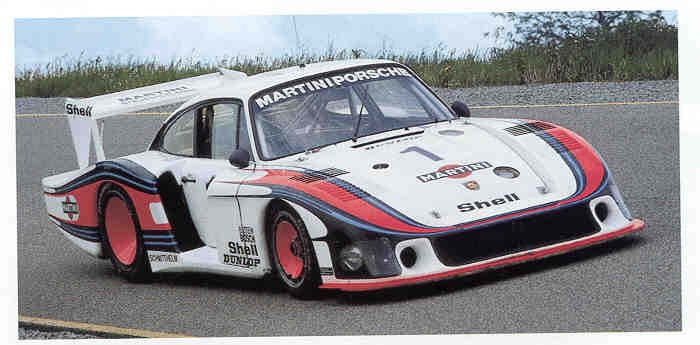|
1973 Daytona Rolex 24-Hour 1973 Sebring 12-Hour 10 national championships in 7 countries. 1974 IMSA GT Champion. Targa Florio win 4th place LeMans FIA World Cup for GT cars. European Hill Climb Champion 1975 Daytona Rolex 24-Hour 1975 IMSA GT Champion. European GT Champion 1st in GT - LeMans |
The 2.7 liter RSs were developed into 3.0 liter RSRs, which
used 917
brakes and center-lock hubs. It began with a 330 hp version of the 911
motor and by the end of 1975, the RSRs developed 345 hp and dominated
GT
racing for 3 years.
Singer's first race car project put him front and center on the international racing scene when the Carrera RSR appeared for the first time at the 1973 Daytona 24 hour race. Competing against established, more powerful 7-liter Corvettes, the 4.4 litre Ferrari 365 GTB4, and Matra and Mirage prototype cars - it beat them all. Only once in 1973 did a Carrera RSR fail to finish a race. An "old" RSR Carrera came back and won Daytona again in 1975. |
|
|
|
|
|
|
|
1969-1989 |
OK, so the factory race team transport was probably NOT one of Singer's projects. But it just seemed to fit here nicely. Brumo's Porsche deserves credit for helping to preserve it, and Singer could have made it the fastest, best-handling race team truck ever. |
|
|
2nd LeMans 2nd Watkins Glen |
Starting with Porsche's 930 street turbo, the oil tank was
moved to
the luggage compartment, other weight-distribution and safety moves
were
made and 917 brakes and turbos were used. But this car was amazingly
stock,
using street torsion bars due to its relatively heavy weight of 2,470
lbs.
mandated by the racing rules. These rules also prevented a focused
effort
at a World Championship, so it was used instead as a test bed for
future
years.
It was the first use of the Bosch K-Jetronic fuel injection in a race motor. Boost adjustable by the driver. Official output was 485 hp at 7000 rpm, but 580 hp or more was reached. By the time it reached 934 specifications, 600 hp was exceeded. At LeMans, they reached 186.4 mph and 0-60mph in 3.2 seconds. |
|
|
1976 - World Marque Championship 3 Consecutive Makes titles 1977 Trans-Am Champion 1978 1st Daytona Rolex 24-Hour |
|
| Read Speedvision's Porsche Racing Heritage article about developing 911 racing variants, here | ||
| The 935 was obviously an evolution of Singer's successful
RSRs and
934s. And yet it was still structurally almost identical to the
production
Turbo. It debuted in 1975 with 590 hp, and by 1977 it put out 845 hp at
8200 rpm, with four valves per cylinder and water-cooled heads. Two,
smaller,
turbo-chargers, each with their own wastegate, were used for less
inertia.
Some were converted back to single turbos for America.
For 1977 Singer utilized a rules change re-defining a car's "body structure" to exclude anything beyond the front and rear bulkheads. He then fashioned bulkhead modifications to fit an even larger, water-cooled intercooler across the car, replacing the two smaller intercoolers used previously. This also allowed him to raise the front suspension wishbone pivot points. He also cleverly interpreted "aerodynamic aids" to include the flared rear end and overhang, completely enveloping the production body rear. It dropped the drag coefficient 10%! |
1978-80 IMSA GT Champion 1979 SCCA TransAm title 1980 Endurance Racing World Championship 1984 - Sebring 1st Overall It eventually won the title: "Greatest Sports Racing Car Ever," and its eligibility in racing was killed. |
|
|
|
|
|
| The Baby was apparently built to show the world that Porsche
could
even win in the smaller formulas, such as those mandating sub-2-liter
motors
(under 1.42 liter if turbocharged) Singer took a 935 and, in 4
months,
squeezed 370 hp from its weeny one- turbo and scrutinized each
component
individually to eventually lighten the car to 1,620 lbs. One
weight-saving
technique included switching back to an air-to-air intercooler, made
possible
by a "jet system" cooling venturi, droping the front radiator. Aluminum
tube subframes were also used. It used a solid titanium shaft rather
than
a differential.
In its second race, at Hockenheim in 1977, Jacky Ickx put it on pole and easily won, besting everyone by 2 seconds per lap. Then it was retired to the Porsche museum, having done what was needed. |
1977 -Hockenheim victory |
|
 |
1978 - Marque title 1979 1st LeMans 1979 - it won12 out of the 15 races it entered that year 1979 1st Daytona Rolex 24-Hour 1983 1st Daytona Rolex 24-Hour 1983 1st Group B LeMans |
The long-tail Moby Dick (shown "officially" here at left) was
the final
evolution of the 935.
Each cylinder head sported four hollow, sodium-cooled valves. Gearing was used instead of a timing chain. In 1978 Singer again showed his genious by taking advantage of a rule which allowed raising the floor of the cockpit to the level of the door sills. This rule was apparently intended to allow turbo-charging exhaust systems for front-engine cars. Singer cut away the entire floor, replacing it with welded aluminum tubes and a fiberglass pan, allowing then the front and rear bulkheads to be lowered, essentially lowering the entire car by 3 inches - legally! A 935 was timed at LeMans at 227.5 mph. |
|
|
|
|
Click here for a very impressive chart of Porsche specifications, courtesy of Singer Fan Fernando Lecaros of Santiago de Chile, South America.